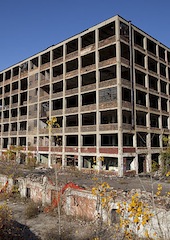What Really Ails Detroit
Stephan Richter’s NYTimes Oped: Detroit’s collapse — bad luck, globalization to blame or indicative of a U.S.-wide problem?
August 16, 2013

Is Detroit’s collapse the story of one American city gone awry? Or is it indicative of a more profound nationwide problem? The facts point to the latter.
Though Detroit’s bankruptcy is exceptional in many ways — notably, its size and its disproportionate impact on African-Americans — the overall decline of America’s manufacturing centers is evident in the deterioration of many smaller cities and towns throughout the Midwest and Northeast.
What accounts for this sad turn of events?
The traditional narrative holds that globalization, outsourcing and, after 2007, the recession have been responsible for devastating American manufacturing by moving jobs out of the country in enormous numbers. But at best, that is a convenient half-truth.
American manufacturing has been in trouble even since its heyday, in the 1950s and 1960s, when the United States was the global economic powerhouse and American assembly-line workers earned very decent middle-class wages.
That era of prosperity was not, as is so often claimed, the manifestation of the American dream. Rather, it was, or should have been, a warning sign that America was riding a fleeting wave of progress. Almost nobody was looking hard enough to the future and asking what it would take to sustain success.
The reason so many manufacturing-sector workers in the United States received such high pay at that time was not that they had exceptional skills or had received superior training; it was that the corporations for which they worked were unsurpassed in their dominance and generated huge revenues.
But that dominance was, to a considerable degree, a momentary quirk of history: the absence, in the wake of World War II, of any real competition from other nations. Once foreign competition was re-established, in Europe and Asia, only the superior skills of a nation’s workers and a focus on long-term workers’ training would allow a country to stay ahead.
For the United States, the day of reckoning came as other nations recovered from the war. In the 1970s, for example, American car manufacturers began facing competition on their home soil for the first time. Belittling the Japanese and their funny little cars was not an effective competitive response, though not for want of trying.
In that moment, American companies, communities and employees should have started taking the competition seriously. That did not happen. Companies like General Motors continued to shower blue-collar workers with handsome pay and benefits.
Who was to blame for this? Not the unions. They did what they were supposed to do: ask for higher pay and more benefits. No, the fault lay with the top corporate managers: it was their job, as capitalists, to deny such increases if they were not justified by productivity trends.
But with a fatal arrogance, executives at American manufacturing companies did allow those increases, in part to maintain a society of contented, trouble-free workers, though executives would also use those increases as cover for their own rapidly swelling compensation. In the 1960s, the average compensation of an American C.E.O. was about 25 times the average compensation of a production worker. That ratio rose to about 70 times by the end of the 1980s, and to around 250 times these days.
It is tragic to hear voices from Detroit declaring themselves ready for a resuscitation of the city. Revival is a question not just of will but also of the available skills base, which unfortunately has deteriorated as a result of a failure to invest in training.
That skills deteriorated is, to a considerable extent, the fault of the unions. Unfortunately, they shared the management class’s shortsighted focus on extracting the maximum amount of compensation from companies, even in the face of the underlying businesses’ failing strength.
Developing the necessary skills base is not a short-term project. It requires decades of concerted effort on many fronts, by many national, regional and local actors, including collaboration among companies, government, trade associations, schools, colleges and universities.
This kind of common purpose, however, is not something that American society, with its ethos of individualism and personal independence, seems capable of undertaking. Doing the right thing for the long haul is typically put off for a later time, if it ever happens.
That such a “strategy” is self-defeating ought to be obvious. Sadly, it is not — not in an instant-gratification world.
Globalization, in many ways, serves as an early warning system for the changes required in a domestic society. No society should have been better prepared to utilize this tool than the United States, given its traditional — but at least for now largely lost — proclivity to embrace change. That it didn’t work out that way is a tragedy of the nation’s own making.
Editor’s note: This essay by Stephan Richter, publisher & editor-in-chief of The Globalist, originally appeared in the New York Times on August 15, 2013.
Takeaways
Detroit's dominance was a brief quirk of history: the post-WWII absence of real competition from other nations.
The cause of Detroit’s decline was not globalization, but a severe case of national shortsightedness.
All the emergence of globalization did was expose the failings that had occurred in Detroit beforehand.
The closest any workers on the world got to the communist dream occurred in the postwar Detroit.
What has been going on in U.S. rust belt towns is precisely what Europe's periphery is going through now.

